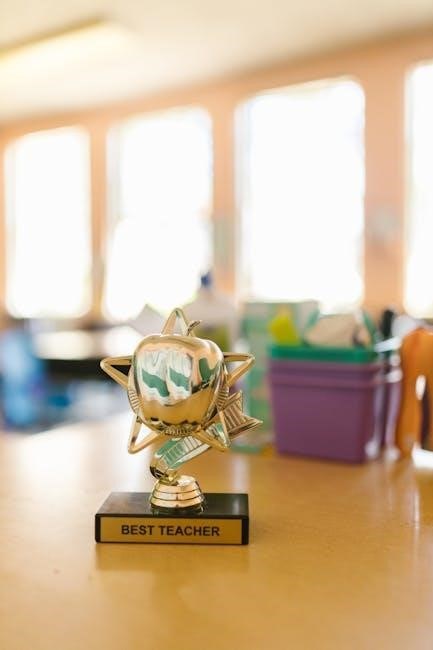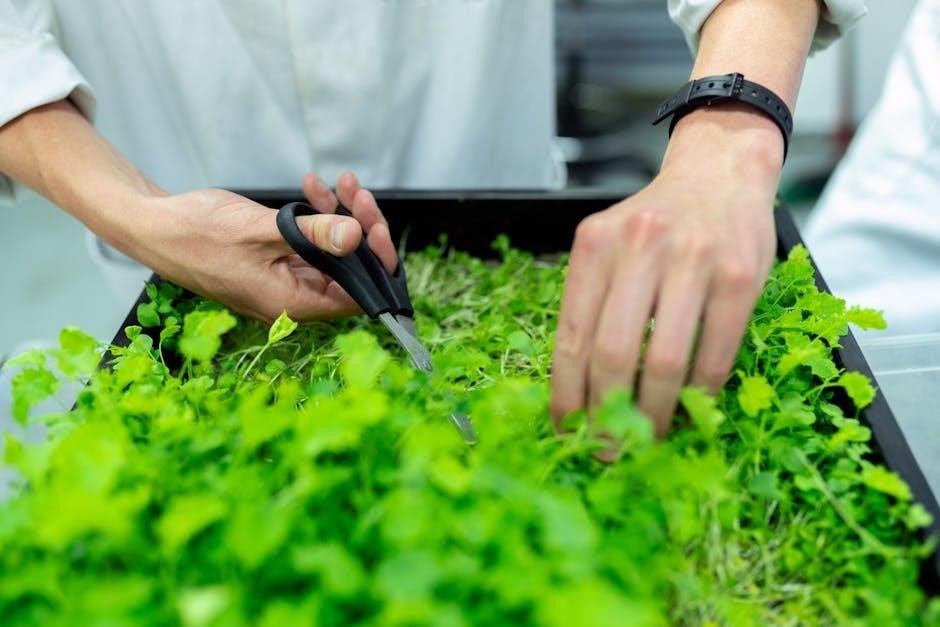Welcome to the Relationships and Biodiversity Lab Teacher Guide, designed to explore ecological interactions and biodiversity principles. This guide provides educators with practical activities, real-world applications, and resources to engage students in understanding the intricate connections within ecosystems, fostering a deeper appreciation for nature and conservation.
1.1 Overview of the Lab Guide
This lab guide offers a comprehensive framework for exploring relationships and biodiversity, providing educators with structured lesson plans, hands-on activities, and assessments. It covers ecological interactions, species diversity, and conservation strategies, aligning with educational standards. The guide includes practical exercises, data collection methods, and tools for fostering STEM skills. By integrating real-world examples and case studies, it encourages critical thinking and environmental stewardship, ensuring students gain a holistic understanding of biodiversity’s role in sustaining life and ecosystems.
1.2 Importance of Biodiversity in Educational Settings
Incorporating biodiversity into education fosters a deeper understanding of ecological balance and sustainability. It encourages students to appreciate the interconnectedness of species and ecosystems, promoting environmental awareness. By integrating biodiversity concepts, educators can develop critical thinking and scientific literacy. This approach also supports cross-disciplinary learning, linking biology, chemistry, and social sciences. Engaging students in biodiversity studies prepares them to address global challenges, inspiring future stewards of the planet and fostering a lifelong commitment to conservation and sustainability efforts.

Understanding Biodiversity
Biodiversity refers to the variety of life at genetic, species, and ecosystem levels. Understanding it is crucial for appreciating ecological balance and addressing global environmental challenges effectively.
2.1 Definition and Scope of Biodiversity
Biodiversity, short for biological diversity, refers to the variety of life on Earth, encompassing all levels from genes to ecosystems. It includes genetic diversity within species, species diversity, and ecosystem diversity. This concept measures the complexity and richness of life, highlighting interactions between organisms and their environments. Understanding biodiversity’s scope is essential for addressing ecological balance, conservation efforts, and the interconnectedness of species within natural systems, ultimately shaping strategies to protect and sustain life on Earth.
2.2 Key Concepts: Genetic, Species, and Ecosystem Diversity
Biodiversity is comprised of three key components: genetic, species, and ecosystem diversity. Genetic diversity refers to the variation in genes within a species, enabling adaptation to environmental changes. Species diversity measures the variety of species in an ecosystem, reflecting its complexity. Ecosystem diversity encompasses the range of habitats and biological communities, such as forests, wetlands, and coral reefs. Together, these concepts highlight the intricate web of life, underscoring the importance of preserving biodiversity at all levels to maintain ecological balance and health.

Ecological Relationships
Ecological relationships describe the interactions between species and their environment, shaping biodiversity and ecosystem function. These relationships include symbiosis, predation, and competition, maintaining nature’s balance.
3.1 Symbiotic Relationships: Mutualism, Commensalism, and Parasitism
Symbiotic relationships are vital for biodiversity, involving close interactions between species. Mutualism benefits both, like pollinators and flowers. Commensalism aids one without harming the other, such as remora fish with sharks. Parasitism harms the host, like ticks on mammals. These interactions shape ecosystems, influencing survival and biodiversity. Understanding these dynamics helps students appreciate ecological balance and species interdependence in nature.
3.2 Food Webs and Energy Flow in Ecosystems
Food webs illustrate the complex pathways of energy and nutrients through ecosystems, showing how species interact as producers, consumers, and decomposers. Unlike food chains, food webs depict multiple feeding relationships, highlighting biodiversity’s interconnectedness. Energy flows unidirectionally, with only 10% transferring between trophic levels, explaining ecosystem dynamics. This structure emphasizes the role of keystone species and the cascading effects of their loss, underscoring the importance of maintaining balanced ecosystems to preserve biodiversity and ecological stability.

Lab Activities for Exploring Biodiversity
This section provides hands-on activities, including fieldwork, species inventories, and ecosystem simulations, to help students explore and understand biodiversity through practical, engaging experiences.
4.1 Designing a Local Ecosystem Study
Designing a local ecosystem study involves selecting a study site, defining research questions, and planning data collection methods. Students learn to observe and record species interactions, habitat characteristics, and environmental factors. This activity encourages critical thinking and scientific inquiry while fostering an appreciation for local biodiversity. By conducting fieldwork, students gain practical experience in ecological research and develop skills in data collection and analysis. This hands-on approach helps bridge theoretical concepts with real-world applications, enhancing their understanding of ecosystems and conservation.
4.2 Conducting a Species Inventory
Conducting a species inventory involves systematically identifying and cataloging plant and animal species within a defined area. This activity teaches students to use field guides, observation techniques, and sampling methods. By recording species abundance and distribution, students gain insights into ecosystem composition and biodiversity. The inventory also highlights the importance of taxonomy and data accuracy, preparing students for more advanced ecological studies. This hands-on approach makes learning engaging and reinforces the value of meticulous scientific documentation in biodiversity research.
4.3 Analyzing Food Chains and Food Webs
Analyzing food chains and food webs helps students understand energy flow and nutrient cycling in ecosystems. By mapping predator-prey relationships, students can identify key species and their roles. Food webs reveal biodiversity’s complexity, showing how species depend on one another. This activity includes creating diagrams, discussing trophic levels, and exploring how disruptions, like invasive species or habitat loss, impact ecosystem balance. It fosters critical thinking about ecological interactions and their importance in maintaining healthy, resilient environments.

Data Collection and Analysis
This section focuses on methods for collecting biodiversity data and analyzing ecosystem health. Techniques include species inventories and biodiversity indices to assess environmental impacts and conservation efforts effectively.
5.1 Methods for Measuring Biodiversity
Measuring biodiversity involves assessing species richness, abundance, and genetic diversity. Techniques include species inventories, quadrat sampling, and biodiversity indices like the Shannon Diversity Index. These methods help quantify ecosystem health and identify conservation priorities. Genetic diversity can be measured through DNA analysis, while species distribution mapping provides insights into population dynamics. Practical applications in the lab allow students to apply these methods, fostering hands-on learning and a deeper understanding of ecological principles.
5.2 Using Biodiversity Indices to Assess Ecosystem Health
Biodiversity indices, such as the Shannon Diversity Index and Simpson Index, are tools to quantify ecosystem health. These indices measure species richness and evenness, providing insights into ecosystem stability. Higher diversity typically indicates healthier ecosystems. Teachers can use these indices to help students analyze data, fostering understanding of ecological balance and conservation priorities. Practical applications in the lab enable students to apply these tools, promoting hands-on learning and a deeper appreciation for biodiversity’s role in sustaining life.

Human Impact on Biodiversity
Habitat destruction, climate change, pollution, and overexploitation of resources disrupt ecosystems, leading to biodiversity loss. These human activities threaten species survival and ecological balance, highlighting the urgent need for sustainable practices.
6.1 Habitat Destruction and Fragmentation
Habitat destruction and fragmentation are major threats to biodiversity, occurring due to deforestation, urbanization, and infrastructure development. These activities disrupt ecosystems, isolating species and reducing their living spaces. Fragmented habitats hinder migration, breeding, and resource access, leading to population decline and extinction risks. Understanding these impacts is crucial for developing conservation strategies to protect vulnerable species and restore degraded ecosystems, ensuring the survival of diverse life forms in a rapidly changing world.
6.2 Climate Change and Its Effects on Species
Climate change significantly impacts biodiversity by altering ecosystems, disrupting species interactions, and threatening survival. Rising temperatures and extreme weather events change habitats, forcing species to migrate or adapt. Many cannot cope, leading to population declines or extinction. This disruption cascades through food webs, weakening ecosystem resilience. Understanding these effects is vital for developing strategies to mitigate biodiversity loss and protect vulnerable species in the face of global warming.

Conservation Strategies
Conservation strategies focus on protecting endangered species, restoring habitats, and engaging communities in sustainable practices to preserve biodiversity and promote ecosystem health for future generations.
7.1 Protecting Endangered Species
Protecting endangered species is crucial for maintaining biodiversity and ecological balance. Conservation efforts focus on habitat preservation, captive breeding programs, and anti-poaching measures. Legislation and international agreements play a key role in safeguarding vulnerable species. Educating communities and involving them in conservation initiatives fosters sustainability. By addressing threats like habitat loss and climate change, we can ensure the survival of endangered species. These strategies highlight the importance of human stewardship in preserving biodiversity for future generations.
7.2 Restoring Degraded Ecosystems
Restoring degraded ecosystems is vital for reviving biodiversity and ecological functionality. Techniques include reforestation, wetland reconstruction, and soil rejuvenation. Community involvement is essential for long-term success, as local stakeholders can contribute to sustainable practices. Restoration efforts also mitigate climate change by enhancing carbon sequestration and improving water cycles. Monitoring biodiversity during restoration helps track progress and ensure the recovery of native species. These initiatives not only heal damaged environments but also promote ecosystem resilience, benefiting both wildlife and human communities.

Case Studies in Biodiversity Conservation
This section highlights successful biodiversity conservation efforts through real-world case studies. It explores species recovery programs, community-based initiatives, and their impact on ecosystem health, providing practical insights for educational applications.
8.1 Successful Examples of Species Recovery
Case studies reveal remarkable species recoveries, such as the reintroduction of the gray whale and the restoration of the black-footed ferret. These examples demonstrate effective conservation strategies, including habitat restoration, captive breeding, and community engagement. By analyzing these success stories, educators can illustrate the importance of targeted interventions and inspire students to contribute to biodiversity preservation. These real-world examples provide practical insights into the challenges and triumphs of species recovery efforts globally.
8.2 Community-Based Conservation Initiatives
Community-based conservation emphasizes local involvement in biodiversity protection. Initiatives like indigenous-led forest management and urban green space projects highlight the importance of grassroots efforts. By engaging communities, these programs foster a sense of ownership and sustainability. They often integrate traditional knowledge with scientific practices, ensuring culturally appropriate solutions. Educators can use these examples to teach students about the value of collaborative conservation and the role of local communities in maintaining healthy ecosystems and promoting biodiversity.

Integrating Biodiversity into the Curriculum
Integrating biodiversity into the curriculum involves incorporating ecological concepts across subjects. This approach fosters interdisciplinary learning, engaging students in science, math, and art through biodiversity themes and hands-on activities.
9.1 Cross-Disciplinary Teaching Approaches
Integrating biodiversity into the curriculum can be achieved through cross-disciplinary teaching methods. By linking biodiversity concepts to subjects like science, math, art, and language arts, educators create a holistic learning experience. For instance, students can analyze biodiversity data in math class, explore ecological art, or write creative stories about ecosystems. This approach not only enhances understanding but also encourages critical thinking and creativity across subjects.
- Encourages interdisciplinary connections
- Fosters creativity and critical thinking
- Provides diverse learning opportunities
9.2 Engaging Students in Biodiversity Projects
Engaging students in biodiversity projects fosters hands-on learning and real-world application. Activities like species inventories, food web analyses, and ecosystem restoration allow students to explore biodiversity firsthand. These interactive approaches encourage critical thinking, collaboration, and problem-solving skills. By involving students in meaningful projects, educators inspire a deeper appreciation for biodiversity and empower the next generation to address environmental challenges. Such experiences often spark a lifelong interest in conservation and sustainability.
- Hands-on activities promote active learning
- Encourages collaboration and critical thinking
- Prepares students for real-world environmental challenges
The Relationships and Biodiversity Lab Teacher Guide effectively explores ecological connections and biodiversity, equipping educators with tools to inspire students to value and protect life’s diversity.
10.1 Summary of Key Concepts
This guide emphasizes biodiversity’s critical role in sustaining life, exploring genetic, species, and ecosystem diversity. It highlights ecological relationships, such as symbiosis and food webs, and human impacts like habitat loss and climate change. Conservation strategies, including species protection and ecosystem restoration, are central. By engaging students in hands-on activities and real-world case studies, the guide fosters a deeper understanding of biodiversity, encouraging stewardship and critical thinking about ecological balance and sustainability.
10.2 Encouraging Lifelong Learning About Biodiversity
Encouraging lifelong learning about biodiversity involves fostering curiosity and stewardship in students. By integrating biodiversity into curricula and extracurricular activities, educators can inspire a deeper connection with nature. Encourage students to explore local ecosystems, participate in citizen science projects, and engage with conservation efforts. Providing access to diverse resources and promoting interdisciplinary learning can nurture a lifelong appreciation for biodiversity, empowering future generations to become informed and active environmental stewards.

Additional Resources
Explore recommended readings, online tools, and databases to enhance biodiversity education. Resources include the Biodiversity Data Journal, conservation databases, and practical activity guides for interactive learning.
11.1 Recommended Reading for Teachers
Essential resources include JM Robinson’s 2024 book on biodiversity and human health, and H Liang’s 2023 study on urban green spaces. The Biodiversity Data Journal offers peer-reviewed articles, while the Convention on Biological Diversity provides comprehensive guides. These materials, along with World Health Organization reports, equip educators with practical tools and global perspectives to integrate biodiversity into their curriculum effectively, fostering both student engagement and professional development.
11.2 Online Tools and Databases for Biodiversity Education
Utilize the Biodiversity Data Journal for peer-reviewed, open-access articles and data sharing. The Convention on Biological Diversity and World Health Organization websites offer educational resources and databases. Additional tools include the IUCN Red List for species conservation status and the Global Biodiversity Information Facility for species occurrence data. These platforms provide educators with interactive maps, species inventories, and research tools to enhance biodiversity lessons and promote student engagement in ecological studies.
